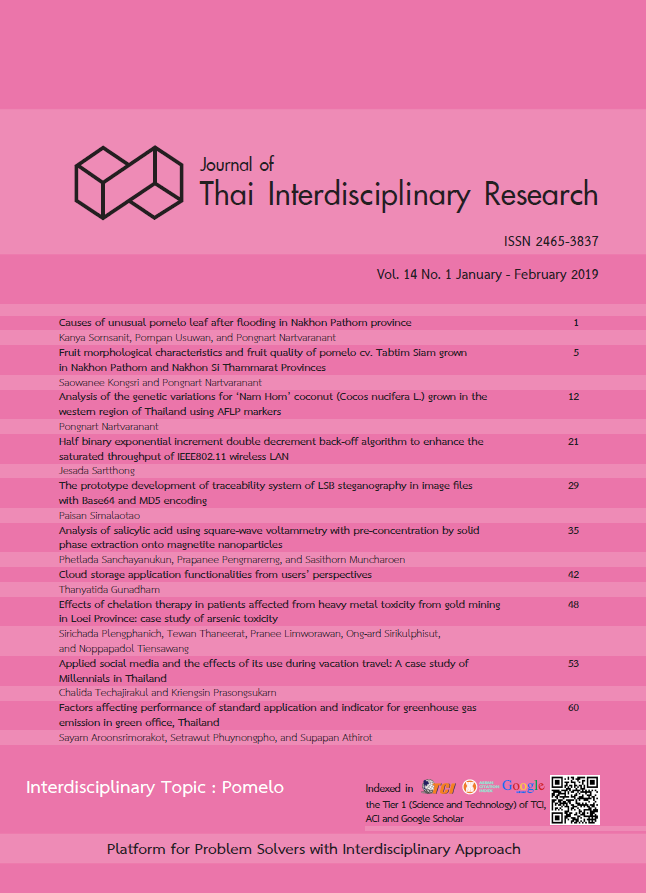Half binary exponential increment double decrement back-off algorithm to enhance the saturated throughput of IEEE802.11 wireless LAN
Main Article Content
Abstract
In wireless local area network (WLAN), the back-off algorithm is used to reduce the collided packets in carrier sense multiple accesses with collision avoidance protocol (CSMA/CA). Normally, the collided packets occur when two or more packets are sent in the same timeslot. This research proposes a new back-off algorithm in retransmission process for improving the saturated throughput of IEEE802.11 WLAN. A proposed scheme is called half binary exponential increment double decrement (HBEIDD) back-off algorithm. The throughput performance of a proposed algorithm is compared with four existing back-off techniques namely: double increment double decrement (DIDD), exponential increment exponential decrement (EIED), binary exponential increment half decrement (BEIHD), and random increment binary exponential decrement (RIBED) back-off algorithms. The accuracy of all back-off algorithms is compared in a discrete time Markov chain model in fixed back-off states and contention window (CW) sizes. Numerical results show that the saturation throughput of HBEIDD back-off algorithm is more stable than the existing back-off techniques under high traffic load condition.
Article Details
References
Bianchi G. Performance Analysis of the IEEE 802.11 Distributed Coordination Function. IEEE Journal on Selected Areas in Communications. 2000; 18: 535-547.
Tinnirello I, Bianchi G. Refinements on IEEE 802.11 distributed coordination function modeling approaches. IEEE Transactions on Vehicular Technology. 2010; 59(3): 1055-1067.
Kwak BJ, Song NO. Performance Analysis of Exponential Backoff. IEEE/ACM Transactions on Networking. 2005; 13: 343-355.
Chatzimisios P, Vitsas V. Boucouvalas AC, Tsoulfa M. Achieving performance enhancement in IEEE 802.11 WLANs by using the DIDD back-off mechanism. International Journal of Communication Systems. 2016; 20: 23-41.
Chatzimisios P. Performance modelling and enhancement of wireless communication protocols.[Dissertation]. United Kingdom: Bournemouth University; 2004.
Song NO, Kwak B, Song J, Miller L. Analysis of EIED backoff algorithm for the IEEE 802.11 DCF. Proceedings of IEEE Vehicular Technology Conference. 2005; 13: 2182-2186.
Jeonghoon M. Performance Modeling of Communication Networks with Markov Chains. Seoul Korea: Morgan & Claypool Publishers; 2010.
Sartthong J. Backoff algorithms optimization for wireless local area networks[dissertation]. King Mongkut’s Institute of Technology Ladkrabang; 2014.
Balador A, Movaghar A, Jabbehdari S. History based contention window control in IEEE 802.11 MAC protocol in error prone channel. Journal of Computer Science. 2010; 6(2): 205-209.
Rajagopalan N, Mala C. History based probabilistic backoff algorithm. American Journal of Engineering and Applied Sciences.2012; 5(3): 230-236.
Sumathi N, Sumathi CP. Backoff schemes for mobile adhoc networks- A survey. Journal of Wireless Networking and Communications. 2013;3(1): 1-5.
Anderton CW, Young M. Is our model for contention resolution wrong?. 9th ACM Symposium on Parallelism in Algorithms and Architectures. 2017; 5(1): 15-27


